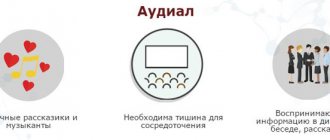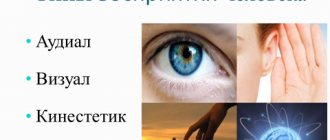Online test
Have you ever wondered which sense organs respond more quickly to interaction with the environment? Have you tried observing your loved ones? How those around you perceive the world: visually, auditorily or tactilely. This technique will help you understand these issues and understand yourself and your loved ones better.
The auditory, visual, kinesthetic test will require about 10 minutes of your free time. Each person has one of the sense organs as the leading one. It is the first to react to signals from the outside, analyzes the information received faster and provides a better answer. People with similar types can understand each other better, and those whose types do not match are more likely to conflict in everyday life. When you know a person's leading type of perception, you understand how best to convey information to him, how to understand what this person is trying to tell you, and how to reconcile your habits and needs.
Test to determine the dominant type of perception
A person receives information from the outside world through 5 sensory channels: visual, auditory, tactile, olfactory and gustatory. Each of these channels, in turn, occupies a place of certain importance in the overall system of perception. Significance refers to the volume, importance and quality of information received. As a rule, there are 4 main types of perception - auditory, visual, kinesthetic and digital (logical). We offer you a test that will allow you to determine your dominant type of perception.
This test is a list of 48 statements to which you must answer “agree” or “disagree” as applied to yourself. Write down the numbers of statements with which you agree on a sheet during the test. In order for the results to have the least error, you need to try to abstract yourself from the fact that you are taking a test and try to simply answer the questions, trying to immerse yourself in your feelings in relation to the phrases proposed below. 1 – I like to watch clouds and stars 2 – I often hum to myself 3 – I don’t recognize uncomfortable fashion 4 – I love going to the sauna 5 – The color of a car is important to me 6 – I recognize by the steps who has entered the room 7 – It entertains me copy someone's dialect 8 - I spend a lot of time on my appearance 9 - I really like massage 10 - when I have time, I like to look at people 11 - I feel bad when I don't enjoy walking 12 - looking at some clothes in a store, I am convinced that I will feel good in it 13 - when I listen to an old melody, I remember the past 14 - I often read while eating 15 - I talk on the phone very often 16 - I think that I have a tendency to be overweight 17 - I prefer listening to a book than reading it myself 18 – after a difficult day, my body is in tension 19 – I have fun and take a lot of photographs 20 – I remember for a long time what friends and acquaintances told me 21 – I easily give money for flowers, because they brighten my life 22 – I like to take a hot bath in the evening 23 – I try to write down my affairs 24 – I often talk to myself 25 – I take a long time to come to my senses after a long trip in the car 26 – I can learn a lot about a person by the timbre of their voice 27 – I very often evaluate people by the way they dress 28 – I like to stretch and straighten shoulders, stretch while working 29 – a bed that is too hard or soft is a torment for me 30 – it’s not easy for me to find comfortable shoes 31 – I really like going to the cinema 32 – I can recognize a person’s face even after many years 33 – I like to walk in the rain when drops tap on the umbrella 34 – I can listen to what they say to me 35 – I like to dance, and in my free time I also go in for sports 36 – when I hear the clock, I can’t sleep 37 – I have a high-quality stereo system 38 – when I hear music, I start beat time with your foot or fingers 39 - on vacation I don’t like to look at architectural monuments 40 - I can’t stand clutter 41 - I don’t like artificial fabrics 42 - I think that the atmosphere of a house depends on the lighting 43 - I like going to concerts 44 - a handshake can tell a lot about a person 45 – I enjoy visiting museums and exhibitions 46 – serious discussion is an exciting activity 47 – touch can tell much more than words 48 – I can’t concentrate in noise Processing test results :
| Audial | 2, 6, 7, 13, 15, 17, 20, 24, 26, 33, 34, 36, 37, 43, 46, 48 |
| Visual | 1, 5, 8, 10, 12, 14, 19, 21, 23, 27, 31, 32, 39, 40, 42, 45 |
| Kinesthetic | 3, 4, 9, 11, 16, 18, 22, 25, 28, 29, 30, 35, 38, 41, 44, 47 |
Place the numbers you wrote down in those sections where they appear in the above table of answers. Calculate in which section you got the most numbers (statements with which you agree) and see your dominant type of perception. If the number of digits is approximately equal in each section, then you do not have any one dominant sensory system and your type is digital (or discrete). Auditory learners construct the world by ear. As one heroine of Ostrovsky’s comedy said: “How will I know what I’m thinking about if I don’t say it out loud?” These are people who are prone to long conversations. And not for the sake of the interlocutor, but in order to listen to yourself, your loved one. They like the way voices sound and melody and rhythm are important to them. But the meaning of what was said or sung is not very good. Auditory types, unlike other types, are always looking for a way to talk. They may start a discussion on a completely trivial topic or, during a business call, begin to comment on situations that have nothing to do with you. At the same time, they will use not only “auditory” words, but also the vocabulary of kinesthetic and visual learners. Often, in order to remember what they just heard, they repeat it several times. Their voices, as a rule, are expressive and melodic. Auditors prefer to sit upright, but leaning slightly forward. Another characteristic pose is called “telephone” - the head is slightly to one side, closer to the shoulder. They often prop it up with their hand or fist. Eye contact during communication is not important to them. Everything you want to convey to the auditory needs to be told with expression, and important points should be highlighted with intonation. When he expresses his thoughts, it is better not to interrupt, otherwise he will start over or refuse to speak at all. If an audio person says “listening”, most likely he is on your “wavelength”. And you will set him up to receive your thoughts with the words “talk”, “discuss”, “ask”, “explain”. Visuals are people who think primarily in visual images. They love to dress beautifully and always pay attention to the appearance and color of the item. They usually have well-developed visual memory. They are wonderful storytellers. But, without seeing the interlocutor (on the phone), most of the information falls on deaf ears. The visual strives not only for beauty, but also for order. A tie on a colleague that is tied incorrectly or a speck of dust on his sleeve “disturbs his life.” A typical example is Hercule Poirot, the great detective fictionalized by Agatha Christie. During a conversation, they need to see the interlocutor, so they try to keep him at an “official” distance and look directly, often into the eyes, without floating their gaze in space. Visual learners are afraid of other people's touch. They express their thoughts more often hastily and loudly, in high intonations. They love to criticize and say phrases like: “I already see what you want to say.” The skin color of visuals is usually pale, and the lips are thin and narrow. They stay straight when walking and sitting. This type of people is easy to recognize by the words: “beautiful”, “seems”, “obviously”, “I see” in the meaning of “I understand”, “clear”, “look”. By the way, if a person often rubs his eyes, then he is most likely a visual person. To convey information to a visual person, try not to lower your eyes during a conversation. And it is very important to maintain a distance, because if it is broken, the visual will move away from you until it runs away in the literal sense of the word. Anything important should not be explained with fingers, you just need to show it. Moreover, not only colorful pictures will be useful, but also ordinary diagrams and graphs. So, if you are going to propose an interesting idea to a visual reader, put your thoughts on a sheet of paper. It is best to use the words “look”, “you will see the result”, “from this point of view”. This is how you translate your thoughts into his language. If you need to refuse the visual, it is best to use language like: “I don’t think (or don’t see) this as right.” Kinesthetics prefer to perceive life through sensations. They need to touch everything, twirl it, try it on their teeth. They act without much thinking, intuitively, succumbing to emotions. The majority are conservatives by nature. For example, they may constantly dress in the same sweater, worn to holes, because they are used to it. A kinesthetic person, while talking, often does not look at the interlocutor, although he comes as close as possible. So, if a colleague, while discussing current accounting matters with you, impulsively grabs your buttons, elbow or shoulder, do not rush to think badly of him. Kinesthetic learners find it difficult to stay still. While talking or thinking, they walk around the room, and while sitting they are constantly “fiddling around.” Moreover, they sit leaning forward and hunched over. They prioritize convenience rather than beauty, so the kinesthetic workplace becomes a mess. Despite their impetuousness and usually large physique, such people are quite flexible. A striking habit of a kinesthetic person is rubbing their hands or stroking themselves on some part of the body, for example on the knee. His voice is quiet and soulful. He tries to say something meaningful and not throw words into the wind. “I feel”, “I will contact you”, “touch on the problem”, “I don’t catch the meaning”, “solid foundation” - expressions from his active vocabulary. People of this type learn new information, although thoroughly, but not immediately; they often ask again, so they have to explain it several times. Kinesthetic learners are people of action, and in order to convey a new idea to them, it is better to do so. Present the current situation as a problem, using the words “inconvenient”, “awkward”, “don’t you feel (don’t feel)?” And then offer a ready way out of the situation, emphasizing that everyone will be “calm” and “comfortable.” Simultaneous recording helps kinesthetic learners to assimilate information well. They perceive it through the sensations of the hand. So invite him to draw a diagram himself or fill out a form, count in a column, press the keys. There is another way of perceiving the world. The person who uses it is called digital , or discrete . For digital, all five senses are important and it has a completely special, rationalistic way of thinking. Such people are benefit-oriented. They work and live without unnecessary emotions and are very afraid of communication, since they are internally very sensitive and vulnerable. They handle words well, avoiding ambiguous interpretations. They also like to compose pompous and “abstruse” phrases. All of them are also great intellectuals. But there are very few of them, and female digital artists are almost never found. Their favorite words are “I understand”, “you know”, “reasoning logically”, “we come to a conclusion”. With digital you need to speak exclusively to the point, armed with a bunch of papers: laws, instructions and, most importantly, certificates with a certain number of seals and stamps. The more numbers the better. It is especially important to ensure the accuracy of the wording. And be sure to maintain a distance and not enter “foreign” territory. information used from the sites: https://www.nlp.ee/library-75961/sbornikstatei/nlpstatji/448-nlp8 https://euroeducation.com.ua/article/40-razlichnaya-topics/91-audial-visual- kinestetik-how-to-determine-the-dominant-type-of-perception.html
Personality types by type of perception
Compare for yourself: here’s how representatives of different types of perception (perception) understand that someone is passionate about them:
- Visual - will notice an interested, loving look.
- Kinesthetic - will feel tenderness or trembling in touch.
- Auditory - will pay attention to special softness or excitement in the voice.
- Discrete (or digital) - will build logical chains in the mind and evaluate the actions of the object of its attention.
- Visual. Such a person relies on the organs of vision, and therefore often uses phrases in his speech that are associated with this to describe his impressions. For example: “I don’t see anything wrong with...”, “I see you...”, “This is the best thing I’ve seen!” and so on. This type of personality receives maximum information from visual materials, drawings, photographs and other visual images. This way he remembers the material better, and when reproducing it, he first of all remembers the visual aspects: colors, outlines, symmetry.
- Kinesthetic. This type relies on tactile sensations, so in his speech you can trace phrases such as “This affected me...”, “It gives me goosebumps”, “How coldly you react...”. When describing something, the first thing he will do is name textures, shapes to the touch, temperature: “The day was warm and humid...”. In conversations, such a person is often interested in your personal subjective experiences; he can sympathize with both positive and difficult experiences, for example, illness.
- Audial. This type perceives all sound, intonation and noise elements more acutely. They are characterized by statements such as “I haven’t heard anything useful”, “Sounds tempting”, “Like a knife on glass”, etc. Such people are better oriented in acoustic information and sense any phenomenon.
- Digital (or discrete). Such a person may seem rather dry because he pays more attention not to vivid imaginative impressions, like other types, but to the internal connections of objects and phenomena. Such a person quickly grasps the essence of what is happening, sees the system in the arrangement of elements, and is inclined to theorize. However, such people are quite sensitive and receptive, and behind the cold calculation lies an inquisitive person who strives for knowledge. You can recognize such a person by his speech by hearing the phrases “Based on this, we conclude...”, “Let’s evaluate the input data,” “There is logic in this!” etc. When communicating with such a person, it is recommended to use more facts, argumentation and statistical data.
Perception test: auditory, visual, kinesthetic, discrete?
Author of the material:
Inna Trofimova
writer, psychologist, gestalt therapist
With this test you can determine the leading source of information perception. Classically, 3 types were distinguished: visual, auditory and kinesthetic . In modern approaches, another type is distinguished - discrete . So let's find out who you belong to. The test has 30 questions, you must answer all of them. Remember that there are no right or wrong answers in the test, answer quickly - the answer that comes to mind first is the true one.
1. I consider it natural and simple for a person when he
2. Remember a party in a cafe with friends. What comes to your mind first?
3. When receiving new information, it is important for you first of all:
4. When something is explained or described to me, I learn best if:
5. When talking with your opponent, what affects you most is:
6. What do you think is the best way to communicate with friends:
7. How do you feel about dancing:
8. You need to make an important decision. What is most important to you in this case?
9. You...
10. The hardest things for me in stressful situations are:
11. Easiest and simplest for you:
12. What is best remembered in your head:
13. Remember your impressions when you walked through the autumn forest. What comes to your mind first?
14. It’s easier for me to collaborate with people I like:
15. What is important to you when talking with other people:
16. What do you consider the best birthday gift for yourself:
17. When buying a new mobile phone, what do you pay most attention to?
18. Have you dreamed of participating in the creation or filming of films? What would you like to do:
19. Based on what you make decisions:
20. Have you ever vacationed at sea in the summer? Remember your impressions. What comes to your mind first?
21. What you remember best is:
22. When I am asked an important question:
23. You have an old but favorite thing. You want to wear it, but it already looks really bad:
24. Remember your “last call” at school. What comes to your mind first?
25. You most understand yourself and what you want when:
26. When you are in conflict with another person, what touches you most:
27. What guides you when you are about to make an important decision:
28. I open up best to people when they are able to:
29. When working with other people, what I want most is:
30. I consider myself:
Additional Information:
- Test for Eysenck's temperament type online
- Test for the leading subpersonality: child, adult, parent?
- Personality type test
- Test for introvert and extrovert
- Character test
- Test optimist or pessimist?
- Brain hemisphere test
How else can you understand what type of perception prevails in a person?
Visual perception
Visual learners need vivid images and clarity, both in learning and in play. They are very fond of beauty, fine art, they are inspired by colorful paintings, elegant sculpture, the concept of “love at first sight” was definitely introduced by the visual! When choosing a clothing style, such a person will rely more on the effectiveness of his own image than on comfort.
These are dreamers, when thinking about something, such people usually look at the ceiling. Representatives of the visual type of perception will prefer books with illustrations, comics or movies to audio recordings. When this person listens, he always looks at the person’s face, at his facial expressions and gestures.
Auditory perception
Representatives of the auditory type of perception subtly sense intonation, rhythm, and various sounds of the surrounding world. Such a person can close his eyes, listening to something, recognize someone walking by the sound of footsteps, and quickly find the sources of subtle sounds. An auditory learner will prefer an audiobook or a radio play and will not avoid communicating on the phone. In complete silence or in a stressful situation, he can begin to hum a melody, voice a plan of action, and stimulate his auditory canal in every possible way.
On the other hand, such a person gets tired of constant noise and needs silence while studying or working. Such people are more likely than others to notice the peculiarities of the speech of others and control their own voice well. These are talented musicians, announcers, and audio transcribers.
Kinesthetic (tactile) perception
A kinesthetic person loves to move, receive information from touch, such a person tries everything on himself. These are active people who often choose sports, extreme sports, cooking or applied arts as a profession or hobby. A classic kinesthetic learner will talk about dynamics, victories, achievements; it is important for him to conquer this world. Looking at people, they notice their gait, posture, and athletic training. They often offer active recreation to their friends. To remember information, they need to try to do something on their own, as in the example, write it down with their own hand, try on an outfit to imagine if it fits. When thinking, these people often look down and to the side.









